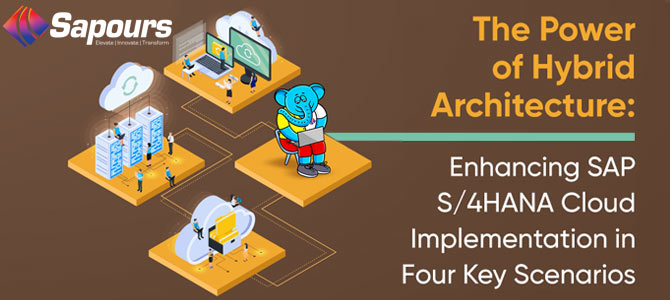When implementing SAP S/4HANA, many organizations aren’t sure what architecture they should go for. Should they go for a fully on-premises model, or should they embrace a complete cloud architecture? The decision to adopt any architecture depends on various factors specific to each organization, including its IT landscape, business requirements, and compliance needs.
Here are four instances when hybrid architecture makes the most sense for SAP S/4HANA Cloud implementation:
1. When you want to meet the complex needs of your HQ and lean subsidiaries
If your business is spread across geographies, opting for SAP S/4HANA Private Cloud Edition (PCE) or on-premises (OP) deployment isn’t feasible. Rather, a hybrid architecture makes the most sense, as it offers the best of on-premises and cloud-based solutions. Such an approach can help you meet the specific needs (and constraints) of smaller, less complex business units or subsidiaries while enabling the following:
Cost Optimization
Lean subsidiaries have limited resources and budgets. A hybrid architecture aids in optimizing costs as it leverages existing on-premises infrastructure and gradually transitions to the cloud for specific processes or functions.
Scalability
A hybrid model allows subsidiaries to scale their IT resources up or down based on fluctuating business demands. They can keep their core processes on-premises to enjoy higher stability and control. They can also execute non-critical or temporary projects in the cloud without the need for costly on-premises infrastructure.
Compliance
As subsidiaries operate from different geographical locations, they need to comply with specific regulations. A hybrid SAP S/4HANA architecture allows data to be stored locally to meet specific compliance requirements and manage data localization and compliance needs effectively.
2. When you want to adopt SAP SuccessFactors, Hybris, etc.
Choosing a hybrid architecture when adopting SAP SuccessFactors or SAP Hybris offers several benefits and advantages. Such an architecture allows you to cater to the unique requirements and challenges of your workforce, as well as meet the evolving needs of your customers. Here are the top reasons to opt for a hybrid architecture when implementing SAP SuccessFactors or SAP Hybris:
Data Security and Compliance
Many organizations, especially those in highly regulated industries, may have strict data security and compliance requirements that necessitate keeping sensitive customer and employee data on-premises. A hybrid architecture helps maintain critical data in a secure on-premises environment while leveraging the cloud for non-sensitive processes.
Integration Flexibility
For companies that already have on-premises systems in place, a hybrid approach enables them to integrate SAP SuccessFactors or SAP Hybris with their current systems. Based on their requirements (and comfort level), they can then gradually transition to a cloud-based solution at their own pace while minimizing disruption to ongoing HR operations or customer service processes.
Data Residency and Privacy Concerns
In some regions or industries, there may be legal or business reasons that mandate data residency or sovereignty requirements. A hybrid SAP S/4 architecture allows organizations to keep sensitive HR and customer data in secure locations while still taking advantage of cloud-based functionalities to drive better engagement and experiences.
3. When you want a bridge until S4HC functionality is in place
As an intelligent cloud ERP, S4HC offers the latest features and capabilities and paves the way for continuous innovation. But not all organizations can or need to adopt all the features offered at once. If you want to continue running your business until S4HC functionality is in place, you can opt for a hybrid architecture, which allows for:
Innovation
Moving non-core functions to the cloud enables organizations to access the latest SAP innovations and updates more easily. By rapidly provisioning cloud services, they can drive continuous improvement and stay a step ahead of their competition.
Risk Mitigation
Adopting a hybrid architecture also reduces the risk associated with a complete Big Bang migration to the cloud. By transitioning incrementally, organizations can thoroughly and carefully test and validate their migration to SAP S/4HANA and ensure a smoother and more controlled migration process.
Performance Optimization
In some scenarios, organizations might require high-performance processes that benefit from being located close to other business functions within the on-premises infrastructure. A hybrid model allows processes with low latency or extensive computing resources to remain on-premises while still leveraging the cloud for less resource-intensive tasks.
4. When you want to support legacy systems
Many established organizations may have invested significantly in their legacy systems and have intricate customizations and integrations. A hybrid approach allows businesses to gradually transition specific business units or processes to the SAP S/4HANA cloud while keeping essential legacy systems running. If you want to support your legacy systems, a hybrid architecture allows for:
Integration
A hybrid SAP S/4HANA architecture allows organizations to enable seamless integration between their legacy and cloud systems and applications. Enabling real-time data exchange and collaboration between different entities allows them to cater to evolving business needs while also meeting essential data security and compliance requirements.
Backup and Disaster Recovery
Leveraging a hybrid architecture can provide robust data backup and disaster recovery capabilities, ensuring business continuity and data protection in the event of unexpected outages or disasters. Such an approach also minimizes disruption and allows for careful testing and optimization before migrating the entire legacy system to the cloud.
Data Mapping and Transformation
Legacy systems often use different data structures and formats compared to modern SAP solutions. With a hybrid architecture, you can define data mapping and transformation rules and ensure data is correctly exchanged and translated between systems during integration.
Embracing a hybrid architecture for SAP S/4HANA Cloud implementation allows you to leverage the best of both worlds: the control and security of an on-premises environment along with the flexibility and availability of cloud-based solutions.
Engage with a skilled SAP S/4HANA partner today to gradually migrate your SAP instance to the cloud and meet specific business requirements.

